Hi, I'm Luis Johnson, an automobile technician, and power equipment professional. By profession, I'm a businessman and operate a car workshop. I have created this...Read more
Every car owner runs into a dead battery from time to time, regardless of make or model. However, most of us know the correct approach to get rid of that issue using another car battery and clamps.
Anyway, what if the battery is dead right when your nearest and dearest are out of the home? Or you’re in a secluded area where finding another car is next to impossible. Can you jump-start a car without another car there? Yes, you can.
But, how to start a car with a dead battery without another car? Luckily, you have multiple options here. For instance, you can go for a bump or push start, use a jump start box, or use your household items. Now, get ready to start your car no matter what the situation is.
Recommended for you: What Causes A Dead Cell In A Car Battery?
How To Start A Car With A Dead Battery Without Another Car?
There are several clever tactics that can be used to re-energize your battery when you get stranded with a dead car battery. These can be a lifesaver when faced with major trouble in the middle of the road.

Now it’s time to discuss them elaborately. However, be sure to carefully follow the directions and carry out these techniques prudently, particularly when you are in a crisis.
Method 1: Try Push Or Bump Start
As for the first method, you may need the help of someone else. However, be damned, an additional vehicle. Yes, we’re referring to push-starting your car. This is such a widespread method you might have seen it at least once in your driving time when people are trying to push start their cars.

Performing this method on yourself on a roadway is fairly rare. But, if you plan to do this on a hill, even you could do it alone. This method uses the centrifugal force created by rotating your car’s wheels.
Note that this technique is only viable for vehicles with manual transmission due to the inclusion of open clutches in automatic transmission vehicles. Here is how to push start a car:
Step 1: Turn the Ignition On and Keep it On Position 2
Inevitably, you have to turn on the ignition switch first. However, make sure it’s on position 2 since it unlocks the steering wheel as well.
Step 2: Press the Clutch Down and Choose Your Preferred Gear
While many people suggest keeping the car in second, we suggest you do whatever you deem most practical. For instance, if you think it’s safe to go backward, choose the reverse gear.
However, if you are going forward and there is hardly any space, first gear should be your option or pick the second gear if you crave a bit more speed.
Step 3: Start Pushing the Car
Now it’s time to push the car. So, tell your friend to push the car from behind. Be sure to clear the steering wheel so that others can push your car.
You possess more knowledge and experience driving your car than others do. An expected velocity of 8 to 10 km/h is ample for most vehicles to begin moving.
To ensure that no one will be hurt while you get out of the car, keep the handbrake released and that the gearbox is in a neutral position.
Step 4: Pull the Clutch Up
Pull the clutch up as the car reaches 5-10 km/h speed. If you’re in the first gear, shift it to the second. However, don’t rush to do this, and press the gas pedal gently.
Tips: Cautions to consider for Push Or Bump Start
Even though push or bump-starting your car is one of the easiest methods, it can end in something possible if you’re not cautious enough. So, before you opt for push-start method, read the following points:
Carefully Check your Surroundings
Think of your moving direction ahead of time, keeping in mind that you will likely have only enough room or slope for a single launch at the start. So make sure the way you’re going to move is clear of people or any obstacles.
Turn on the Hazard Lights
Being witnessed when stranded on the road is a key factor in safely dealing with a vehicle that won’t start. Ensure that you always set your vehicle’s hazard lights on so other vehicles can see your position.
If your car’s battery cannot provide enough juice to start consistently, use your safety mirrors as a backup.
Method 2: Use A Jump Start Box
Like jump-starting with another car, using a jump-starter box to start your car involves keeping your power sources carefully stowed in your vehicle.
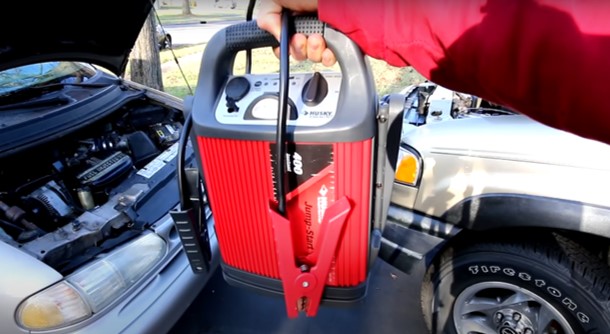
One advantage of using this technique is that you are able to make it happen without any assistance by simply having your jump starter on hand.
In addition, they include USB-accessible plugs, so it is possible to recharge the car’s onboard safety lights, the AC outlet, and even your smartphone. You’ll save money, too, since these portable batteries are typically not expensive.
However, they are only intended for use on vehicles with automatic transmissions. Follow the process outlined below.
Step 1: Keep Your Jump-starter Box Fully Charged
The first thing you have to do is keep your jump starter box charged. To some people, it may be seen as an unnecessary suggestion.
However, as we mentioned, jump-starter boxes are useful for other purposes; you may certainly perform that, forget your option, and will ultimately not be able to use this feature in that situation.
Because of this, regularly inspect the battery jump box to prevent a battery empty condition. You’ll need to charge the jump box when you might have both an empty jump box and a discharged battery.
Step 2: Attach the Clips
If you’re still using a traditional spring-based jump box model, the jumper cables will be affixed to two sides of the jump box and not directly plugged into the box.

Therefore, you must connect correctly with the jumper cables (i.e., the negative and the positive tabs), connecting the clips to the adaptor posts accordingly.
Step 3: Connect the Cables with Dead Battery Terminals
Pick a red clamp or clip; connect it to the dead battery’s positive terminal. You can identify it with the (+) symbol or the red cover.

Then hook up a black clamp or clip to your vehicle’s frame. Make sure the surface is grounded and unpainted.
Step 4: Turn On the Starter Box
Wait long enough for the battery charge to kick in before turning on the starter.
Some people say you should test the vehicle after one or two minutes. However, in reality, charging the battery can take a significant time, so be patient for at least five minutes.
Step 5: Start Your Car and Remove the Cables
After waiting an adequate amount of time, you can try to start your vehicle. If everything seems okay, simply turn off the starter pack and detach all cables.
Tips: Cautions to follow when Using A Jump Start Box
Unfortunately, if you do not have adequate experience regulating a vehicle, you should not attempt to jump it yourself. First, carefully review the owner’s manual; it might contain valuable instructions.
As you attempt, you must pay closer attention to the metal part of your jack and your vehicle in case any sharp or rough objects could damage your workspace. Never place loose cables underneath the vehicle’s battery.
Method 3: Try Manual Starting by Spinning The Car’s Alternator
Avoid using this method unless you are accustomed to working with cars and trucks and their battery systems. At a minimum, you should opt for this method as a last resort because of the potential for uncontrollable damage to your car.
So, how can you use this method safely? Follow the directions provided below:
Step 1: Disconnect the Battery
First, disconnect the battery before you begin the process of starting the car. This procedure is quite common when it comes to any sort of engine repair.
Step 2: Locate the Fan Belt
Locate the engine fan belt. This is a type of synthetic and flexible rubber belt. For most cars, the belt should be situated at the front of the engine.
Step 3: Remove the Belt
Now you have to remove the fan belt to access your car’s alternator. You must utilize a socket wrench to loosen or a ratchet to remove the belt.
If you have an automatic tensioner equipped with either one or both setups, make sure you manage the tension. Either way, you’ll have to turn your wrench sideways to release the tension. Pull the fan belt off of the different pulleys.
Step 4: Spin the Alternator
As you take the fan belt out, start spinning the alternator manually. Try to spin as fast as you can, and make sure to continue it for a decent amount of time. This will channel some voltage to the battery.
If you have a bicycle nearby, you can use it to do the whole process quickly. After this, try cranking the engine. Hopefully, your car will be started if everything is done properly.
Method 4: Use Household Items
Do you know you have several things nearby that can be used to start your car? If not, here are some surprising tips for you.
Apply Drinking Soda
Yes, you have seen it right. We’re talking about drinking. After the battery has become corroded and battered, use a can of soda to restore power to it. Not that, you can also use coke.
This is due to the fact that it has a relatively low pH, carbonic acid, phosphoric acid, and citric acid, as well as carbonation. Using this combination will thin out corrosion and make a better connection between the terminals and battery clamps.
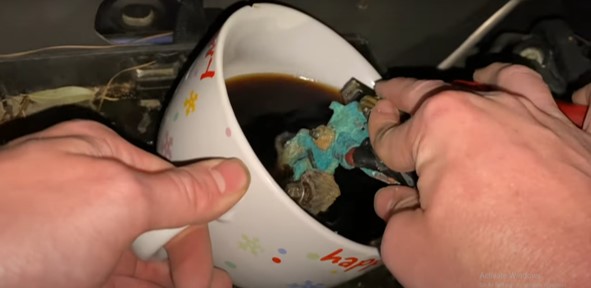
Just be sure your car is in a reasonably safe place, though, because you really do not want to eliminate your electrical components. It is still how you start a car using household items.
Manage An UPS
Now onwards, can you manage a UPS? If yes, you’re in luck. A UPS is now a very popular option because they use lead-acid batteries and have a decent grounding circuit.
One of the issues that you may encounter is that if you have a UPS of considerable size, maybe 24 volts giving off two 12-volt SLA batteries or may just be minuscule, only three volts. You can also convert your UPS to a car battery.
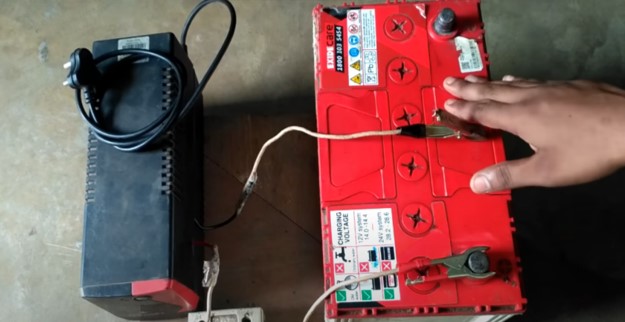
However, you should think about this option only as a temporary solution. This is because there are key differences between a car battery and a UPS due to their intended purposes.
Use A Laptop Charger
Relatively, a lot of AC charging bricks work with a 15-volt supply, but a few have smaller 5-volt circuits. So you have an option in front of you, which is using a laptop charger with a minimum of 15V capacity.
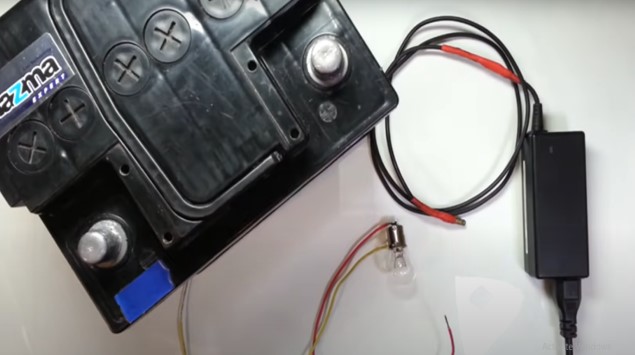
However, carefully monitor the voltage because the charger brick may become warm with low internal resistance.
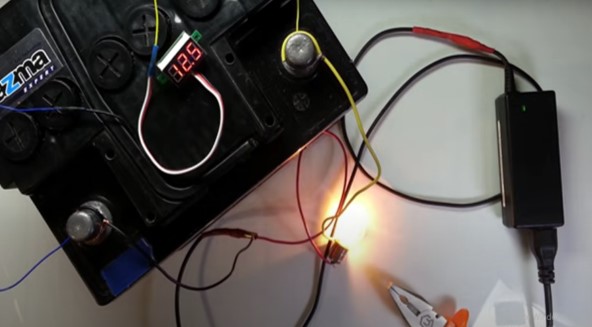
Another thing worth considering is connecting a middle-finger bulb to the charging cord to limit current flow. We would suggest using a flashlight-type bulb to lead.
If you want to make the charging process faster, you need to increase the charging current.
To do so, you must add one more light bulb parallel to the first one. After 15 hours, the battery’s voltage will be increased to 13.9 volts, and the cells will start to release hydrogen.
Method 5: Seek Help with Roadside Assistance
Are you still facing trouble starting your car? Maybe you’re not interested in resorting to any of them? If so, then there’s also a solution: roadside assistance.
You merely need to finish a couple of clicks on the website such as the Roadside Assistance AAA and you’re all set. Reaching out to roadside help is an excellent idea because they’re constantly supplied with jump starters to tackle such situations.
In some worst-case scenarios, they may even tow your car to the auto repair shop, where they can determine what happened and what is keeping it from functioning.
Things to Remember when Starting Your Car Without Another Car
We have mentioned some necessary cautions for specific jump-starting methods. Yet, no matter which method you choose, you should keep in mind the following tips:
Inspect Properly
Inspect your vehicle’s battery cables for the possible existence of splits and breaks. If your car does not start after numerous attempts, try reconnecting each cable individually because sometimes they can be loosened.
Avoid Jump Starting A Car with a Damaged Battery
Remember not to attempt to jump-start a car if its battery has been damaged. It is highly flammable and could cause a fire or an outburst.
Wear Safety Accessories
When working with car parts, especially car batteries, it’s always a good idea to wear safety glasses and use non-conductive mechanic gloves.
Be Wise While Selecting and Storing Starter Pack
If your jump starter does not have important safety features, you will need to have yours repaired or fixed before you rely on it in times of emergency.
Study your jump starter’s back cover to figure out the necessary information. Be sure to store your battery appropriately, or you may need to depend on it in an emergency.
Try to Keep the Car Neutral
Unless you’re approaching the push-start method, make sure the gear for your vehicle is neutral before jump-starting it. Otherwise, your car may accelerate so fast that it could be extremely dangerous.
Frequently Asked Questions
In spite of furnishing you with a good amount of information, you will most likely still have a few questions that remain unanswered. Review the following FAQ section in order to get answers to those queries.
Why Does A Car Battery Die?
Several different explanations may exist for a dead car battery. For instance, the car is left with interior lights or headlights on for a long time, the battery charging system fails, or your car’s battery is older than 5 to 7 years. If your car battery is already dead, follow our guidelines on how to fix a dead car battery to revive your car battery.
Can push starting damage your car?
This will cause some minor extra wear on the drivetrain, but it won’t introduce too many difficulties. Your transmission clutch flywheel wasn’t designed to deal with this all the time; therefore, they’ll endure the brunt of it.
Are jump boxes safe?
Most of the time, using a jump box is perfectly safe, although it is possible to fret about both your vehicle and yourself. If you connect the jumper cables correctly, tie everything together, and don’t make unnecessary assumptions, it’s very easy.
Final Words
By now, you’ve probably learned how to start a car with a dead battery without another car. Proceed with caution and start driving safely.
Even after the car is started, ensure your car’s battery is taken care of by contacting the nearest service center.
If repairs or replacements are required, make it done immediately. When replacing the battery, ensure the new one is compatible with the original battery’s specifications.

Hi, I'm Luis Johnson, an automobile technician, and power equipment professional. By profession, I'm a businessman and operate a car workshop. I have created this site Batteryquery to help people purchase the right battery for their vehicles. The reason behind creating this site is to help my customers purchase the right car battery who often purchase the wrong one due to their lack of knowledge.
More Posts